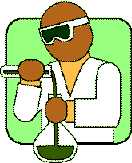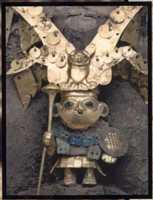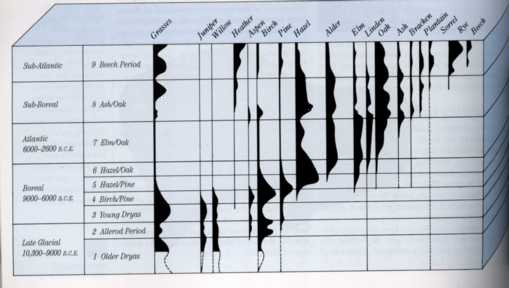
By far the most important work done by an archaeologist is done in the lab. This is where the majority of the time is spent recording, dating, analyzing, studying, cataloguing, and whatever other various things need to be done.
Conservation:
Conservation is very important for preserving the artifacts for further study and storage. In the field, artifacts found have stablized according to the environment, so these artifats must be preserved under similar circumstances to prevent deterioration. An example of this is waterlogged wood. When it dries, the wood gets warpped into a different shape and shrinks, so wax must be used to replace the water so that the original shape and size are saved. Sometimes artifacts must be repaired or restored to their original appearence so that they can studied better and then displayed in museums. Since new techniques are always being discovered, archaeologists only use conservation that can be reversed using solvents.

This was a nose ornament once worn by a warrior of one of the Moche lords buried at Sípán in Peru. It is made of gold and jade.
Cleaning:
Well-preserved specimens can easily be gently washed in clean soft water. Other materials like metals, ivory, tortoiseshell, antler, horn, and objects made from unfired clay must be mechanically cleaned using detal tools and fine blades. Some artifacts are dried by being dipped in alcohol first and then ether, but others need the water removed by replacing it with either wax or polyethylene glycol (PEG). Salts must be immeditely removed from metals because of the extreme damage that they cause. Usually it is best to remove incrusted metals by hand, but if the artifact is stable enough, it can be soaked in clean water. If the surface of pottery or ivory is flaking, then that must be treated first. Before metal objects are treated, they must be carefully examined to assess the current corrosive damage and to determine the strength of the metal underneath as well as any decorations it may have. If there are any decorations then they are top priority of preservation. Usually the artifact is examined using X rays.

Restoration:
The majority of the artifacts and materials found can be mended using adhesives. Epoxy and polyester resins and soluble nylon are ideal as they do not shrink when dried. When pottery is being rebuilt, it is put in a sand tray to hold it together until the adhesive finishes setting. Missing pieces of pottery are refilled using lumps of plasticine.
Organic Remains:
From organic remains, archaeologists can learn more about the ancient environment and also about the economy and the person itself. Bones and antlers, while also used as body or personal ornaments, could also have been used as tols and it is important that archaeologists study the remains to learn more about what the purpose was. By studying animal remains, archaeologists can determine what impact animals and nature had on the economy and culture. The speed of decay in organic remains tends to vary according to the environment and surrounding situations. To see more information about what is preserved where, check out the Overview Page right here in the Archaeology section.

Pollen:
Here is a pollen diagram showing the amounts of pollens present in certain areas during different time periods.
Dating:
Radiocarbon:
Dendrochronology:
Thermoluminescence:
While this may seem unimportant, pollen remains are actually used as a type of dating technique in Europe. Some pollens do not survive over longer periods of time. By looking at pollen grains, archaeologists can determine weather patterns, landscape techniques, and climatic shifts.
For the longest time, chronology was what archaeologists considered to be their primary interest and concern. Before archaeologists can answer the "whats", "wheres", and "hows", they must ask "when?"
The most common type of dating is called Carbon Dating or C-14 Dating. All living things take up C-14 in their lives. C-14 is the radioactive isotope of carbon. After death, the process of taking in radiocarbon stops and the C-14 decays at a known rate. Assuming that the amount of radiocarbon in the atmosphere remains constant, the amount of radiocarbon in the object reflects the time elapsed since the death. C-14 dating only dates organic materials such as plants, animals, bones, skeletons, humans, etc. Radiocarbon dating has coem a long way from when it first started, and as with any other measurement is just that, only a measurement. Archaeologists usually prefer taking an average of many different tests so that they may get a more accurate date. There will always be some kind of problem, like if the organic material is too old then it will be too weak to test, also mixtures of old and new materials may cause some discrepancies.
Put in its simplest terms, this type of dating is tree-ring dating. Trees develop a new ring of tissue each year and their age can be determined by counting the rings in the trunk.
This type mof dating is fairly recent and is what archaeologists have always wanted. TL dates pottery and other artifacts that were fired at very high temperature. When fired, tiny quantities of radioactive matter emit alpha and beta particles which knock electrons out of place. The electrons then becoem trapped irregularly in the clay lattice. Light is given off and then measured along with the remaining radioactive material and the approximate date when the material was fired can be figured out.
The information on this page was mostly found in the book The Practical Archaeologist.
Click here to go back to the Home Page!